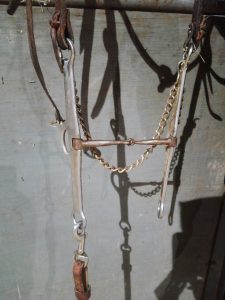Multiple futurity and open 1D champion barrel racer Wenda Johnson uses a 10-inch Les Vogt elevator bit to maintain shoulder control and body position.
About the Les Vogt Elevator Bit
“This bit is more than 20 years old and hard to come by. Les Vogt still carries a new 10-inch elevator with a different look. It is well known in both English and Western disciplines. The legendary horseman Jimmy Williams utilized the elevator bit in his training method with an added second rein at the mouthpiece. Les Vogt, a 15-time world champion, worked toward consistency and longevity in his training methods.”
Mouthpiece: Smooth Single-Jointed Stainless Steel
“This mouthpiece is simple and effective without being too severe. Essentially, if used correctly, the elevator bit can be no more severe than a snaffle.”
Shank: 5-Inch Shank and 5-Inch Purchase
“The purchase—measured from the mouthpiece up—is broad and flat, totaling 5 inches. The shank—measured from the mouthpiece down—is also broad and flat, totaling 5 inches. When the purchase and shank are equal measurements, this is known as a 1:1 ratio. The purchase creates lift and elevation, which assists in shoulder control, and the shank creates ‘whoa.’ With the 1:1 ratio, there is an equal amount of lift and stop. It’s designed to be ridden with a very loose curb strap and soft hands.”

Curb Strap: Loose Chain
“The curb is chain and very, very loose. It flops around during competitive runs and is not ideal with speed, but keeping it loose is essential. If it is tightened, it changes the whole mechanics of the bit and how it was designed to work.”
Who Should Try the Les Vogt Elevator?
“Through the training process when a horse needs help lifting the shoulder, collection at the poll or breaking at the withers would be the appropriate time to utilize an elevator bit. This bit should not be used on a very young horse, and the horse should have a lot of experience before trying the 10-inch elevator. I use it during schooling, practice runs and competitive runs. An experienced rider will gain maximum efficiency while using this bit. It is essential to have soft, quiet hands.”
Using the Elevator
“At slower speeds, I really enjoy this bit. It’s a great training and schooling bit, and I originally had no intentions of using it during a run. It is best utilized at slow and controlled speeds to maximize performance. With added speed, the likelihood of the elevator being used incorrectly increases. However, I am using it during runs on Dreams First Flash to gain and maintain shoulder control through the turns. With each run, I consciously strive to keep my hands as quiet as possible and utilize appropriate timing around the turns. As I slightly lift my hand, I give “Flash” a couple seconds to respond and wait for him to soften. It’s not always about the bit being used—it’s how you use it, and together we find the “feel” that works for us as a team.”
This article was originally published in the December 2018 issue of Barrel Horse News.




